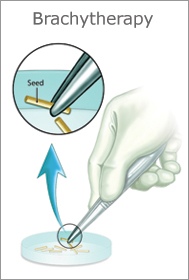 |
| Chemotherapy for Prostate Cancer |
Major Study Shows Early Chemotherapy for Prostate Cancer Extend Patient Life By Almost Two Years
New study suggests that rendering chemotherapy when prostate cancer spreads outside the prostate could prolong patient life by an average of 22 months.
Presently, chemotherapy is normally applied only after hormone therapy is ineffective. But the new study discovered that when the two therapies were combined at the beginning of therapy, prostate cancer patients can lived longer with an average of 10 months.
Prostate cancer is a common disease in men, affecting approximately 41,000 men annually in UK and causing nearly 10,000 deaths per year.
The research run across UK and Switzerland with 2,962 prostate cancer patient participated in the tryout. Approximately 60 per cent of had cancer spread beyond the prostate. The remainders had high risk in locally advanced prostate cancer. Some patients were given six doses of docetaxol at the beginning during their trial.
The study found that when docetaxel chemotherapy was given to those with locally advanced cancer, they survived an average of six years and five months – ten months longer than those who were not given such drugs.
When chemotherapy was given to those with cancer which had spread outside the prostate, the men survived an average of five years and five months.
Dr Iain Frame, Director of Research at Prostate Cancer UK said: “The findings of this trial are potentially game-changing – we can’t wait to see the full results". This could potentially extend the lives of thousands of men with prostate cancer.
Prof Malcolm Mason, from Cardiff University, added: "In prostate cancer it has been used at a much more advanced stage of the illness, for some years - now we know that this chemotherapy should be added earlier, in fact as soon as hormone therapy starts."
“Chemotherapy isn’t suitable for everyone, but all men who are well enough and who have prostate cancer which has spread, should be offered this combination of treatments,” said by Professor Peter Johnson, Cancer Research UK’s chief clinician.
Peter Paul Yu, President of the American Society of Clinical Oncology (ASCO), where full findings will be presented, said: “This is the biggest trial of its kind and strongly suggests that adding chemotherapy to standard hormone therapy can extend the lives of men with advanced prostate cancer.”
Presently, chemotherapy is used only as a last resort for advanced prostate cancer treatments. If chemotherapy is proven to have a a great deal of impact on prostate cancer patients survival rates when prescribed sooner and together with hormone therapy, it should be broght in to the clinic as soon as possible so that prostate cancer suffers can benefit without further delay.
Presently, chemotherapy is normally applied only after hormone therapy is ineffective. But the new study discovered that when the two therapies were combined at the beginning of therapy, prostate cancer patients can lived longer with an average of 10 months.
Prostate cancer is a common disease in men, affecting approximately 41,000 men annually in UK and causing nearly 10,000 deaths per year.
The research run across UK and Switzerland with 2,962 prostate cancer patient participated in the tryout. Approximately 60 per cent of had cancer spread beyond the prostate. The remainders had high risk in locally advanced prostate cancer. Some patients were given six doses of docetaxol at the beginning during their trial.
The study found that when docetaxel chemotherapy was given to those with locally advanced cancer, they survived an average of six years and five months – ten months longer than those who were not given such drugs.
When chemotherapy was given to those with cancer which had spread outside the prostate, the men survived an average of five years and five months.
Dr Iain Frame, Director of Research at Prostate Cancer UK said: “The findings of this trial are potentially game-changing – we can’t wait to see the full results". This could potentially extend the lives of thousands of men with prostate cancer.
Prof Malcolm Mason, from Cardiff University, added: "In prostate cancer it has been used at a much more advanced stage of the illness, for some years - now we know that this chemotherapy should be added earlier, in fact as soon as hormone therapy starts."
“Chemotherapy isn’t suitable for everyone, but all men who are well enough and who have prostate cancer which has spread, should be offered this combination of treatments,” said by Professor Peter Johnson, Cancer Research UK’s chief clinician.
Peter Paul Yu, President of the American Society of Clinical Oncology (ASCO), where full findings will be presented, said: “This is the biggest trial of its kind and strongly suggests that adding chemotherapy to standard hormone therapy can extend the lives of men with advanced prostate cancer.”
Presently, chemotherapy is used only as a last resort for advanced prostate cancer treatments. If chemotherapy is proven to have a a great deal of impact on prostate cancer patients survival rates when prescribed sooner and together with hormone therapy, it should be broght in to the clinic as soon as possible so that prostate cancer suffers can benefit without further delay.



